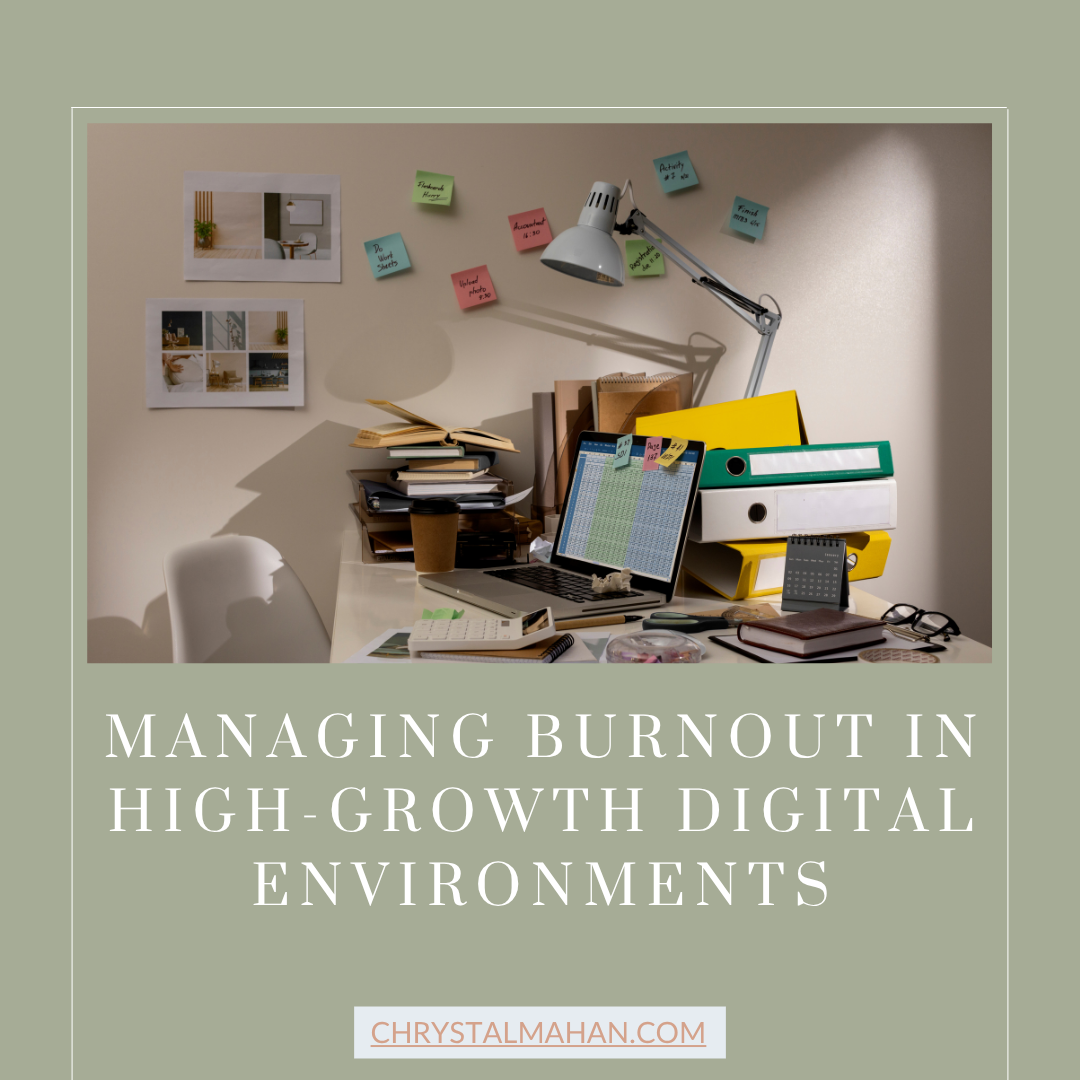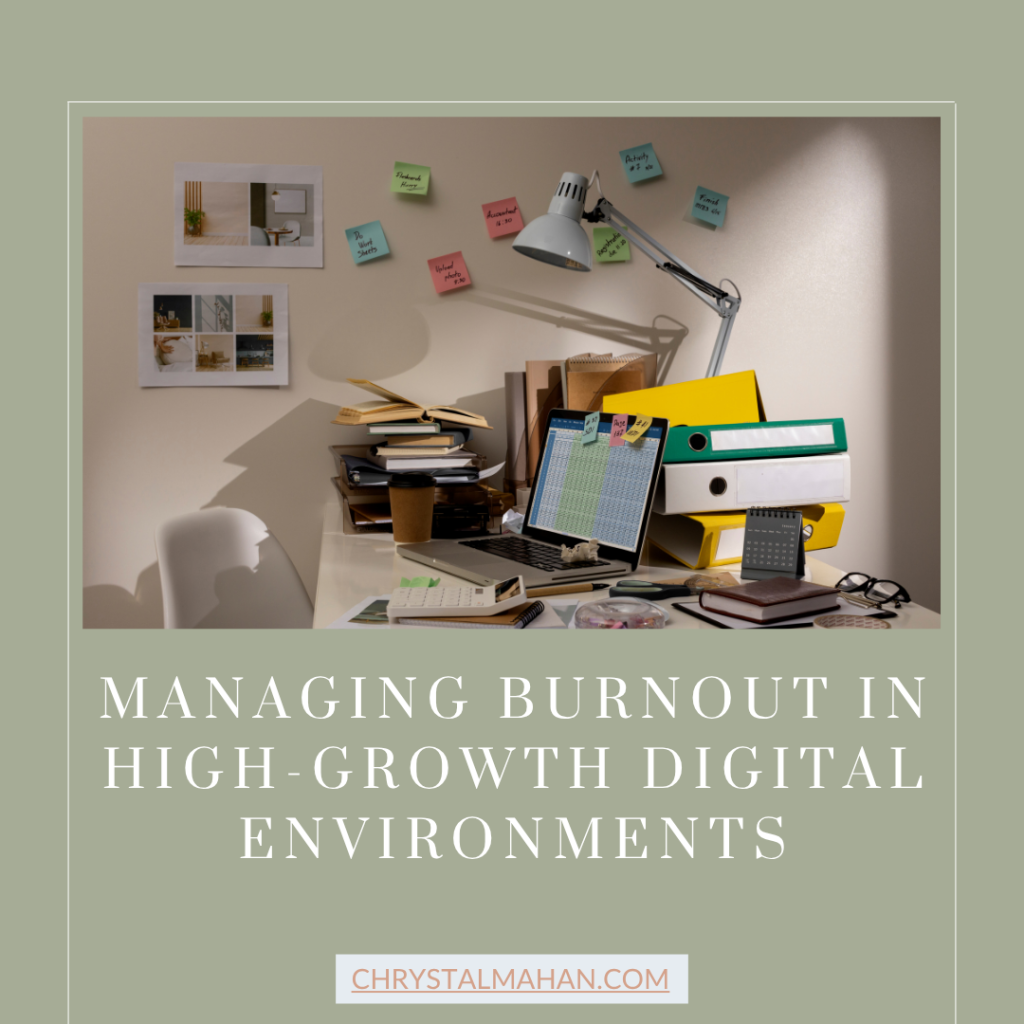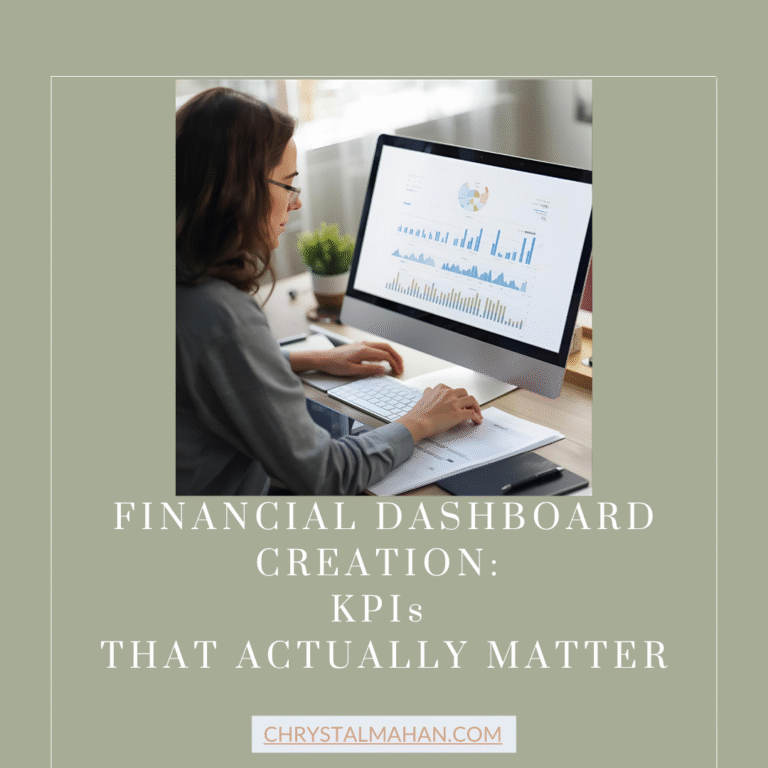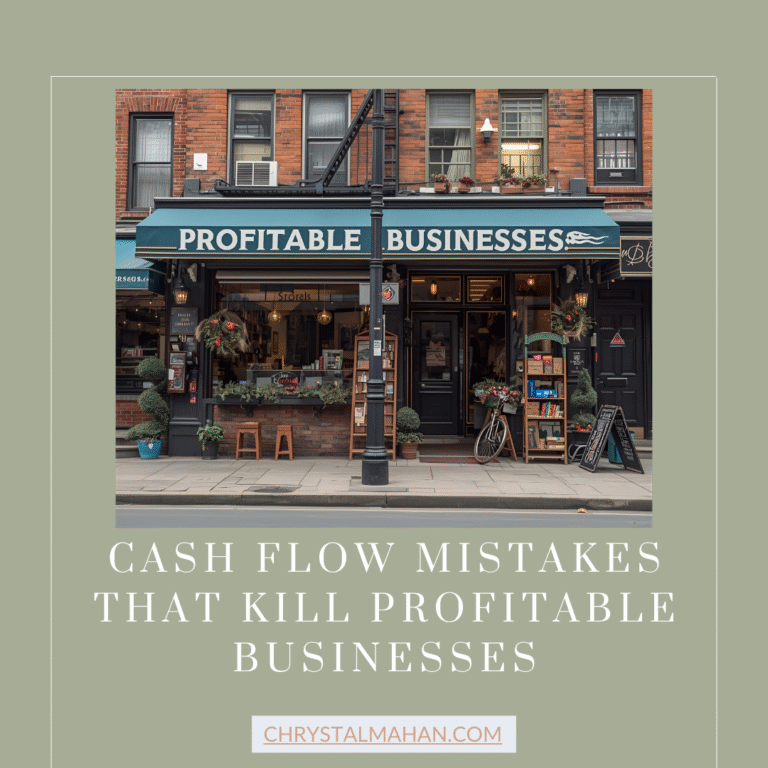Managing Burnout in High-Growth Digital Environments


Your team just closed the biggest quarter in company history, but instead of celebration, you’re fielding resignation letters and watching your top performers disengage. Sound familiar?
Last year, I spoke with a digital marketing agency that had grown 300% in 18 months. On paper, they were the definition of success. New clients were flooding in, revenue was soaring, and industry publications were featuring them as a case study. But behind the scenes, the story was different. Their creative director was working 70-hour weeks, their project managers were making critical errors due to exhaustion, and their company culture had shifted from collaborative energy to survival mode. The founder came to me not because business was bad, but because success was destroying his team.
The truth is, burnout isn’t just a personal wellness issue in high-growth digital environments. It’s a business-critical threat that can derail your success faster than any market downturn. But here’s what most leaders miss: burnout is preventable and manageable when you understand its root causes and implement the right systems. The companies that learn to scale sustainably don’t just survive rapid growth; they use it as fuel for long-term competitive advantage.
Setting the Stage
In the digital business world, growth often happens at breakneck speed. Unlike traditional industries where expansion might take years to materialize, digital companies can experience explosive growth in months or even weeks. A viral campaign, a strategic partnership, or a product launch can suddenly multiply your workload by five while your team size remains the same. This creates a perfect storm for burnout that many leaders aren’t prepared to handle.
The challenge is compounded by the always-on nature of digital work. Your team isn’t just managing more projects; they’re managing them across multiple time zones, platforms, and communication channels. The boundaries between work and personal life blur when your office is everywhere and your clients expect immediate responses. Add the pressure of maintaining quality while scaling rapidly, and you have a recipe for widespread exhaustion.
What makes this particularly dangerous is that burnout in high-growth environments often masquerades as dedication. When someone is working late nights to meet impossible deadlines, it can look like commitment rather than unsustainable overextension. By the time the symptoms become obvious, the damage to both individual well-being and business performance is often significant. The key is recognizing that sustainable growth requires intentional management of human resources, not just financial ones.
Recognizing the Early Warning Signs
Burnout doesn’t announce itself with a dramatic collapse. It creeps in gradually through subtle changes in behavior, performance, and team dynamics. In digital environments, these signs can be particularly easy to miss because remote work and flexible schedules can mask declining engagement. The first indicator is often a shift in communication patterns. Team members who used to contribute actively in meetings become quiet observers. Their emails become shorter and less detailed. They stop volunteering for new projects or offering creative solutions to problems.
Performance changes are another critical signal, but they don’t always look like you’d expect. Sometimes burnout manifests as perfectionism taken to an extreme, where team members spend excessive time on minor details because they’ve lost perspective on priorities. Other times, it shows up as a series of small mistakes that seem out of character for normally reliable employees. You might notice increased sick days, longer response times to messages, or a general decrease in proactive communication.
The most telling sign is often found in team interactions. Burned-out employees tend to become more isolated, avoiding casual conversations and team-building activities they once enjoyed. They may express cynicism about company goals or become defensive when receiving feedback. In digital environments where much of our interaction happens through screens, these emotional cues can be harder to detect, making it crucial for managers to actively check in rather than assume silence means everything is fine.
Creating Sustainable Workflows and Processes
The foundation of burnout prevention lies in building workflows that can handle growth without breaking your people. This starts with ruthless prioritization. In high-growth environments, there’s always more work than time, which means saying no becomes a critical leadership skill. Create clear criteria for what constitutes priority work and stick to them, even when clients or stakeholders push for exceptions. This might mean turning down potentially profitable projects if they would overextend your team beyond sustainable limits.
Process standardization becomes your secret weapon against chaos. When everything is urgent and every client feels like they need special treatment, having documented, repeatable processes creates stability for your team. Develop templates for common deliverables, create checklists for complex projects, and establish clear approval workflows that prevent last-minute changes from derailing timelines. The goal isn’t to stifle creativity but to free your team’s mental energy for strategic thinking rather than figuring out basics every time.
Technology can be a powerful ally in creating sustainable workflows, but only if implemented thoughtfully. Automation should eliminate repetitive tasks, not add another layer of complexity to manage. Project management tools should provide clarity, not become another source of notifications to monitor. The key is choosing systems that grow with you and training your team thoroughly on how to use them effectively. Remember that every new tool requires adoption time and mental bandwidth, so be selective about what you introduce during periods of rapid growth.
Building Resilience Through Communication and Culture
Communication becomes exponentially more critical as your team grows and workloads intensify. In high-growth digital environments, the temptation is to move faster by communicating less, but this approach backfires spectacularly. Instead, invest in more structured communication that provides clarity without consuming excessive time. This means regular but brief check-ins, clear project updates that everyone can access, and transparent sharing of company priorities and decisions.
Create psychological safety by normalizing conversations about workload and stress. Many team members won’t speak up about feeling overwhelmed until they’re already in crisis mode. Regular one-on-one meetings should include specific questions about bandwidth and energy levels, not just project status updates. Train your managers to recognize when someone is struggling and to respond with solutions rather than just sympathy. This might mean redistributing work, adjusting deadlines, or bringing in temporary support.
Culture in a high-growth environment requires intentional cultivation. The casual, family-like atmosphere that works in a small startup can become toxic when growth creates unrealistic expectations of unlimited availability and commitment. Instead, build a culture that celebrates effectiveness over hours worked. Recognize team members who maintain quality while managing their energy well, not just those who are willing to sacrifice everything for the job. Make it clear that sustainable performance is valued more highly than unsustainable heroics.
Implementing Recovery and Prevention Strategies
Recovery from burnout requires more than just telling people to take time off. In high-growth environments, traditional vacation policies often fail because team members feel too guilty or worried about falling behind to actually disconnect. Instead, create systems that make rest not just possible but expected. This might mean implementing mandatory time off, cross-training team members so work can continue in someone’s absence, or establishing blackout periods where non-emergency communication is discouraged.
Micro-recovery becomes crucial when major breaks aren’t feasible. Encourage practices like taking actual lunch breaks away from screens, ending meetings five minutes early to allow transition time, and setting boundaries around after-hours communication. These small practices can significantly impact overall energy levels when implemented consistently across the team. The key is making these practices part of your operational rhythm rather than optional nice-to-haves.
Prevention strategies should be built into your growth planning from the beginning. As you anticipate increased workload, plan for increased support. This doesn’t always mean hiring full-time employees; it might mean engaging freelancers, implementing new automation, or partnering with other companies to handle overflow work. The goal is to scale your capacity to handle work at roughly the same pace you scale the work itself. When you’re reactive rather than proactive about capacity planning, burnout becomes inevitable.
Moving Forward with Intention
Managing burnout in high-growth digital environments isn’t about slowing down or accepting mediocrity. It’s about building antifragile systems that become stronger under pressure rather than brittle. This requires a fundamental shift in how we think about growth itself. Sustainable growth prioritizes building capabilities alongside revenue, investing in systems alongside sales, and developing people alongside profits.
The companies that master this balance don’t just avoid burnout; they create competitive advantages through higher retention, better client relationships, and more innovative solutions. When your team has the mental and emotional bandwidth to think strategically rather than just react tactically, they produce higher-quality work that commands premium pricing and generates referrals.
Remember that preventing burnout is an ongoing process, not a one-time initiative. As your company continues to grow and evolve, your approaches to managing workload and supporting your team will need to evolve as well. The key is maintaining awareness, staying proactive, and always prioritizing the long-term health of your people alongside the long-term health of your business.
Ready to Build a Burnout-Resistant Business?
The strategies we’ve discussed today represent just the beginning of creating a truly sustainable high-growth digital environment. Every business faces unique challenges based on their industry, team composition, and growth trajectory, which means there’s no one-size-fits-all solution to burnout prevention.
If you’re ready to dive deeper into building systems that support both rapid growth and team well-being, I’d love to continue this conversation over coffee. Whether you’re currently dealing with burnout symptoms in your team or want to prevent them before they start, let’s explore what sustainable growth looks like for your specific situation.
Browse through more insights on digital business management in my other blog posts, and don’t hesitate to reach out when you’re ready to transform your growth strategy from reactive to intentional.
Like what you read? Drop me a line – let’s chat over virtual coffee.
~ Chrystal






